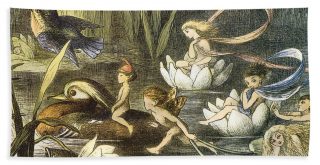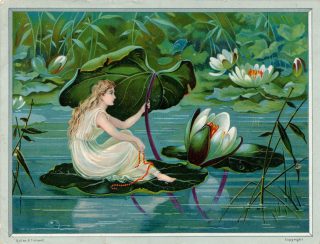Water lily ovvero giglio d’acqua è il nome più utilizzato nel mondo anglosassone per indicare la ninfea. Dal greco “Nymphaia” = pianta delle ninfe, perchè tipica dei boschi e delle zone acquatiche e paludose dimora delle ninfe; il fiore è principalmente un simbolo di trasformazione spirituale, cresce nell’oscurità sotto l’acqua dal fango e cerca la luce in cui vive per aprirsi al giorno donando tutta la sua bellezza.
Water lily from the Greek “Nymphaia” = plant of the nymphs, because typical of the woods and of the aquatic and marshy areas where the nymphs live; the water lily is mainly a symbol of spiritual transformation, it grows in the darkness under the water from the mud and looks for the light in which it lives to open up to the day spreading all its beauty.
Water Lilies (Caprice)
Water Lilies è una poesia scritta nell’Ottocento da Felicia Dorothea Hemans (nata Browne) e messa in musica da Anton Brejestovski per l’album Girdenwodan part 1, 2012 dei Caprice.
Le ninfee si trasformano in barche fatate su cui gli elfi festeggiano la mezza estate.
Music by Anton Brejestovski
Lyrics by Felicia Dorothea Hemans
In this poem written in the nineteenth century by Felicia Dorothea Hemans and set to music by Anton Brejestovski: the water lilies are transformed into fairy boats on which the elves celebrate the midsummer.

I
Come away, Elves, while the dew is sweet (1),
Come to the dingles where Fairies meet;
Know that the lilies have spread their bells (2)
O’er all the pools in our forest dells;
II
Stilly and lightly their vases rest
On quivering sleep of the water’s breast,
Catching the sunshine (3) throught leaves that throw
To their scented bosoms an emerald glow;
Chorus
Come away with me!
for the midsummer (4) sun grows strong,
And the life of the lily may not be long (5)
III
Come away! Under arching boughs we’ll float,
Making those urns each a Faerie boat
Row them with reeds o’er the fountains
free, tall flag-leaf (6) shall our streamer be,
IV
And a star (7) from the depth of each pearly cup,
A golden star unto Heaven looks up,
As if seeking its kindred where bright they lie,
Set in the blue of the summer sky.
[Chorus]
V
And we’ll send out wild music so sweet and low,
It shall seem from the bright flower’s heart to flow,
As if ‘twere breeze with a flute’s low sigh,
Or water drops train’d into melody.
(End)
Come away, Elves,
Come away, Faeries,
Come away, Elves
Come away, Come away, Faeries.
Footnotes
1) it’s the dawn
2) the water lilies open in the morning with sunlight and close again in the evening
3) A Norwegian legend tells us how the water lily was born: once upon a time a nymph lived in a lake. the Sun fell in love with her and going down to the lake in his golden dress.
The Nymph felt miserable and was ashamed of her little pearls dress compared to the god, so she dived in down the deep of the lake, where many treasures were hidden, to show that wealth to the Sun. But the gold weighed too much and the Nymph sank into the muddy bottom. The Nymph cried, begged the Lake Fairy to help her, but no one answered, the mud submerged her little by little, and only her white hands full of gold remained.
According to a very similar variant, the lake nymph falls in love with a beautiful prince, and ashamed of her simple forest clothes, so she dives into the lake to retrieve the treasures that are secretly hidden there. However, the weight of the jewels pushes it towards the bottom and only the white hands laden with gold emerge from the water. The merciful Fairy of the Lake turns it into the flower of the water lily.
4) on the eve of midsummer the fairies gather to make revelry is one of their great feasts of the year
5) the water lily opens on the surface of the water and lasts a few days
6) does it refer to the wheat leaf or the stem of the water lily?
7) it describes the golden heart of the water lilies comparing it to the light of the stars
Caprice, Girdenwodan Part I 2012
Traduzione italiana Cattia Salto
I
Andiam via Elfi mentre la rugiada è dolce,
andiamo alle vallette dove le Fate si radunano,
per certo le ninfee hanno aperto le loro corolle
su tutte le polle nelle nostre conche boscose
II
Immobili e leggiadre le loro coppe riposano
nel sonno tremulo sul seno dell’acqua,
catturando la luce del sole con le foglie che diffondono
ai loro boccioli profumati un bagliore di smeraldo;
Coro
Andiam via!
perché il sole di mezza estate si rinforza,
e la vita della ninfea potrebbe non durare
III
Andiam via! Sotto i rami penduli galleggeremo,
facendo di quelle urne ciascuno una barca fatata
Remiamo con i giunchi verso la sorgente
la libera, alta lamina il nostro vessillo sarà,
IV
E una stella dal fondo di ogni tazza madreperlacea,
una stella d’oro al cielo alza lo sguardo
come se cercasse il suo parente dove giacciono luminosi
incastonati nel blu del cielo estivo.
[Coro]
V
E diffonderemo musica selvaggia così dolce e greve,
sembrerà che sgorghi dal cuore del fiore luminoso,
come fosse brezza leggera con un sospiro basso di flauto,
o gocce d’acqua esperte di melodia.
(Coda)
Andiam via Elfi
Andiam via Fate,
Andiam via Elfi
Andiam via, Andiam via Fate
NOTE
1) [si descrive il momento dell’alba]
2) [le ninfee si aprono al mattino con la luce del sole e si richiudono nel tardo pomeriggio]
3) Una leggenda norvegese ci spiega come è nata la ninfea: un tempo era una Ninfa che abitava in un lago. Raggio di Sole s’innamorò di lei e la volle conoscere scendendo verso il lago nel suo abito tutto d’oro.
La Ninfa si sentì misera e si vergognò del suo abitino di semplici perle al paragone del dio e si tuffò verso il fondo del lago, dove erano nascosti molti tesori, per mostrare quella ricchezza a Raggio di Sole. Ma l’oro pesava troppo e la Ninfa sprofondava nel fondo melmoso. La Ninfa pianse, pregò la Fata del Lago di aiutarla, ma nessuno rispose, il fango la sommerse a poco a poco, e di lei rimasero soltanto le candide mani aperte piene d’oro.
Secondo una variante molto simile, la ninfa del lago si innamora di un bellissimo principe, e vergognandosi dei suoi semplici abiti boschivi si tuffa nel lago per recuperare i tesori che vi sono segretamente celati. Il peso dei gioielli però la spinge verso il fondo e solo le candide mani cariche d’oro emergono dalle acque. La Fata del Lago impietosita la trasforma nel fiore della ninfea.
4) [alla vigilia di mezz’estate le fate si radunano per fare baldoria è una delle loro grandi feste dell’anno]
5)[la ninfea si apre a pelo dell’acqua e vive pochi giorni]
6) [si riferisce forse alla foglia del grano o al fusto della ninfea?]
7) [si descrive il cuore dorato delle ninfee paragonandolo alla luce delle stelle]

LINK
https://ilgiardinodeltempo.altervista.org/ninfea-linguaggio-dei-fiori-miti-e-storia/
https://www.ugopellecchia.it/blog/donna-tra-i-fiori/133-ninfee,-incantesimo-di-acqua-luce-e-petali.html
https://www.hydrophyllum.it/blog/simbologia-del-fior-di-loto-n24
